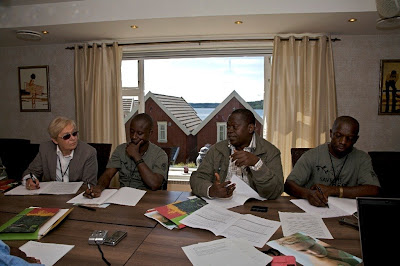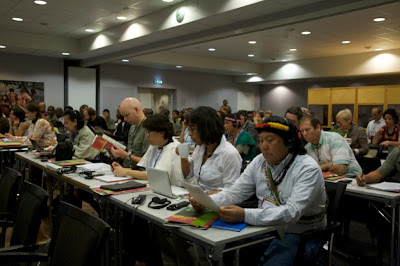.jpg)
Regnskogfondet fyller 20 år! Og feiret det i går på Rockefeller med gode artister, spennende gjester og et herlig publikum. Fotograf: Espen Wæhle.
.jpg)
Hovedøen Social Club startet og avsluttet konserten med deres dansbare salsaversjoner av norske klassikere.
.jpg) Davi Kopenawa Yanomami hilste til Sofieprisvinner Marina Silva og Regnskogfondets daglige leder Lars Løvold og takket for samarbeidet med å kjempe for yanomamienes sak i Brasil.
Davi Kopenawa Yanomami hilste til Sofieprisvinner Marina Silva og Regnskogfondets daglige leder Lars Løvold og takket for samarbeidet med å kjempe for yanomamienes sak i Brasil..jpg) - I think I'm the only artist in the world talking in English and singing in Norwegian? sa Odd Nordstoga til publikum i går. Han kunne også presentere en premiere for anledningen: Bugge Wesseltoft kom opp på scenen og akkompagnerte på piano på siste låta.
- I think I'm the only artist in the world talking in English and singing in Norwegian? sa Odd Nordstoga til publikum i går. Han kunne også presentere en premiere for anledningen: Bugge Wesseltoft kom opp på scenen og akkompagnerte på piano på siste låta. .jpg) Susanne Sundfør hadde reist fra Vestlandet for å spille. Hun har vært engasjert i regnskogssaken lenge, og spilte en spesialkomponert låt til Regnskogfondet for anledningen.
Susanne Sundfør hadde reist fra Vestlandet for å spille. Hun har vært engasjert i regnskogssaken lenge, og spilte en spesialkomponert låt til Regnskogfondet for anledningen..jpg) Petter Nome var kveldens vert og intervjuer her Lars Løvold, ikledd hovedpryden fra Kongo-gjestene.
Petter Nome var kveldens vert og intervjuer her Lars Løvold, ikledd hovedpryden fra Kongo-gjestene..jpg) Dansegruppen Frikar sto for kveldens energiutblåsning med prosjektet "The Snuff Grinders" som blander halling med capoeira og breakdance.
Dansegruppen Frikar sto for kveldens energiutblåsning med prosjektet "The Snuff Grinders" som blander halling med capoeira og breakdance..jpg)
.jpg)
.jpg)
.jpg)
.jpg)
.jpg)

.jpg)

















.jpg)



















